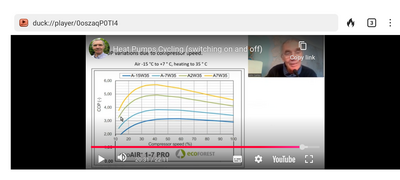Samsung heat pump sizing
Posted by: @bontwoodyAs for future government policies I hope the human race has more collective sense than to destroy its own environment (but I am by no means sure of this).
Worryingly I'm very unsure we have the collective sense to do enough without an emergency, by which time it is probably too late.
As for using the immersion heater when it is really cold outside, I'm all for doing that occasionally if it helps the overall efficiency of the system. When the HP is freezing up and drawing heat out of the tank to defrost I can't imagine the COP is that great anyway. I may as well switch the immersion heater on for an hour or 2 overnight and boost the tank temperature ready for the morning rush. As long as the MCS paperwork can be worked around that option I will probably have that as a fall back. I know the Samsung has a setting to prioritise heating over hot water below a certain temperature so I could switch that on if needed.
@johnnyb Using the immersion wont improve the efficiency but if you can get cheap rate electricity it should be no more expensive and may even be cheaper than having a second hot water run during the day.
Its a strategy that I use effectively but as others have pointed out, there are other options. For me I think I would try and work out just how oversized your selected heat pump would be in the shoulder seasons and base my choice on that. But its just my own opinion.
If I remember rightly, a 5kW heat pump can run quite happily on 22mm copper pipes, whereas an 8kw requires 28mm pipes. Depending on your plumbing that might be a consideration as well.
House-2 bed partial stone bungalow, 5kW Samsung Gen 6 ASHP (Self install)
6.9 kWp of PV
5kWh DC coupled battery
Blog: https://thegreeningofrosecottage.weebly.com/
Heatpump Stats: http://heatpumpmonitor.org/system/view?id=60
Posted by: @bontwoodyUsing the immersion wont improve the efficiency
I was thinking that using an oversized HP just to heat the hot water on a few days but the heating not running as efficiently as it could for most of the heating season probably isn't the most efficient way of speccing it. Fitting the right sized HP for the heating needs then running the immersion occasionally might be more efficient overall?
Think too many people get hung up on the headline kW rating of a heat pump. It isn't important in the slightest in reality.
More important is the modulation and minimum output. So what are looking for a radiator system is the minimum kW at say 30 degs flow and 7 degs outside and an UFH a minimum kW rating at 25 degs at 7 degs outside. They are the more usual operating point for most the heating season.
A lot (not all) small heats are detuned bigger ones, so headline kW output is low, but minimum output can be relative terms be high.
Next thing is heat output area. So bog radiators, to allow meaningful heat transfer at low flow temperature. Then system volume, in general terms a bigger volume system cycles less for a given kW input and the same output from radiators.
So understand
Min modulation value of heat pump first.
Your typical load at 7 degs (generally half you design load)
Your flow temp at 7 degs and do your radiators carry the heat into the rooms well enough to keep the return water temperature low enough to keep heat pump happy.
Your system volume. Around 20L per minimum modulation kW, is a good target.
Cycling is NOT bad, as long as you are controlled, so 2 or 3 cycles an hour is fine. 10 or more is generally bad.
In simple terms imagine a kettle - it puts out a fixed 3kW. Cycle time is controlled by water volume only. More water longer run times, small volume short run.
@johnnyb I believe the jury is hung as to whether an oversized heat pump is actually less efficient. I think most people though agree excessive cycling is bad for the longevity of the compressor.
As Johnmo points out, its the minimum output that will likely be the most important factor with respect to cycling.
House-2 bed partial stone bungalow, 5kW Samsung Gen 6 ASHP (Self install)
6.9 kWp of PV
5kWh DC coupled battery
Blog: https://thegreeningofrosecottage.weebly.com/
Heatpump Stats: http://heatpumpmonitor.org/system/view?id=60
Posted by: @bontwoody@johnnyb I believe the jury is hung as to whether an oversized heat pump is actually less efficient. I think most people though agree excessive cycling is bad for the longevity of the compressor.
As Johnmo points out, its the minimum output that will likely be the most important factor with respect to cycling.
This screenshot from the John Cantnor video on cycling shows why it's highly likely that an someone significantly oversized heat pump is less efficient.
There is one thread on this forum where the poster experienced a 20pc improvement when he switched from a 10kW (in reality a downgraded version of the 12kW Vaillant to the 7kW Vaillant.
The point is that it's not just (or even mainly) about cycling, it's about compressor efficiency.
Based on these observations, and until there is clear evidence to the contrary, I would suggest that it's best to assume that significant oversizing does reduce efficiency
4kW peak of solar PV since 2011; EV and a 1930s house which has been partially renovated to improve its efficiency. 7kW Vaillant heat pump.
@jamespa That was my feeling, but I have seen it argued that oversizing does not cause significant inefficiency, so I erred on the diplomatic side 🙂
House-2 bed partial stone bungalow, 5kW Samsung Gen 6 ASHP (Self install)
6.9 kWp of PV
5kWh DC coupled battery
Blog: https://thegreeningofrosecottage.weebly.com/
Heatpump Stats: http://heatpumpmonitor.org/system/view?id=60
Posted by: @AnonymousThink too many people get hung up on the headline kW rating of a heat pump. It isn't important in the slightest in reality.
More important is the modulation and minimum output. So what are looking for a radiator system is the minimum kW at say 30 degs flow and 7 degs outside and an UFH a minimum kW rating at 25 degs at 7 degs outside. They are the more usual operating point for most the heating season.
A lot (not all) small heats are detuned bigger ones, so headline kW output is low, but minimum output can be relative terms be high.
Next thing is heat output area. So bog radiators, to allow meaningful heat transfer at low flow temperature. Then system volume, in general terms a bigger volume system cycles less for a given kW input and the same output from radiators.
So understand
Min modulation value of heat pump first.
Your typical load at 7 degs (generally half you design load)
Your flow temp at 7 degs and do your radiators carry the heat into the rooms well enough to keep the return water temperature low enough to keep heat pump happy.
Your system volume. Around 20L per minimum modulation kW, is a good target.
Cycling is NOT bad, as long as you are controlled, so 2 or 3 cycles an hour is fine. 10 or more is generally bad.
In simple terms imagine a kettle - it puts out a fixed 3kW. Cycle time is controlled by water volume only. More water longer run times, small volume short run.
I think this is a good point.
We have a massively oversized heat pump (12kW ASHP for a heat loss closer to 4kW), but we have large radiators that allow us to run at a minimum flow temp of 32-33C for the troublesome shoulder months.
The issue is what is the minimum amount of heat that is produced, and what flow temp do I need to dissipate that heat through my radiators (or UFH). If my radiators are large enough that I can dissipate 4kW of heat produced at a low flow temp, then the system should be efficient, even if I only need to turn it on for an hour or two to heat the house, rather than continual running a smaller heat pump constantly putting out a minimum of 2kW.
For us, with our largish radiators and achievable minimum flow temps of 32-33C is shoulder months, the oversized heat pump is pretty efficient when running (sure, 30C would be better, that that's not achievable with our emitter sizes), and is even more efficient when switched off. And in the 3 months of winter we can run almost constantly (the house still gets too hot overnight, even on minimum) so should be at least as efficient as a smaller correctly sized unit, and this is when we incur the majority of our energy usage.
So yes, in my humble opinion, there are worse things than an oversized heat pump. An oversized heat pump with undersized emitters would be much more of an issue, where the system would be running for shorter periods at higher flow temps and cycling more frequently. You must be able to dissipate the heat you are generating.
EDIT: I do take the point about compressor efficiency above, but just as I lose a little efficiency in shoulder months by operating at the low end of the compressor efficiency curve, in winter when I incur most energy usage, I'm probably operating in the 50% sweet spot, whereas a 'correctly sized' heat pump is running near flat out in winter when most energy usage is incurred, at the top end of that compressor efficiency curve where efficiency is tailing off again.
Samsung 12kW gen6 ASHP with 50L volumiser and all new large radiators. 7.2kWp solar (south facing), Tesla PW3 (13.5kW)
Solar generation completely offsets ASHP usage annually. We no longer burn ~1600L of kerosene annually.
And it's still down to different opinions 🤣 Maybe I'm over thinking it?
8kW when I only need 5 feels like a significant oversize to me. I haven't found the minimum output of the heat pumps to see how well they modulate down when it is warmer, which is where most of the heating season is.
THe house is UFH downstairs and in the bathrooms then pipework only installed to the bedrooms for rads if we feel we need them in the winter. They design temperature is current 43° for peak load so the figures don't really make much sense. As we aren't intending to fit rads yet I haven't questioned the size of them.
If I have another Homley installed that will stop any short cycling, it switches the heating off when the difference in the flow and return gets to small. (It is supposed to keep the efficiency good, but the efficiency figures Homely gives on line are so different to the Samsung figures that I have no real idea of how efficient the system is running.)
Posted by: @johnnyb
8kW when I only need 5 feels like a significant oversize to me. I haven't found the minimum output of the heat pumps to see how well they modulate down when it is warmer, which is where most of the heating season is.
Firstly, most of the heating season in terms of time, but not in terms of energy usage. You will use more energy in the coldest two months than you do in the milder 4 months of the heating season.
Most manufacturers do not publish that data. Some do - look for the minimum electrical input for the flow temps and ambient temps you may run, and then you can calculate the output from multiplying by the COP at those temps. Otherwise, a good rule of thumb is around 25% of it's rated output. Alternatively, just ask any existing owner, what is the minimum current draw they experience in mild weather - for me that's just under 1kWh (maybe 0.9kWh) for my 12kW Samsung unit (which is actually a de-rated 16kW unit) giving around 4kW of heat output depending on the COP at the time, so I know I need large enough emitters to be able to dissipate 4kW of heat at low flow temps. 4kW minimum output is in keeping with the 25% rule of thumb from the 16kW rating of the underlying hardware I have (as the 12kW unit uses the same compressor as in the 16kW model).
Samsung 12kW gen6 ASHP with 50L volumiser and all new large radiators. 7.2kWp solar (south facing), Tesla PW3 (13.5kW)
Solar generation completely offsets ASHP usage annually. We no longer burn ~1600L of kerosene annually.
Posted by: @old_scientistmaybe 0.9kWh) for my 12kW Samsung unit (which is actually a de-rated 16kW
Which is very similar to our 6kW heat pump. As I keep saying ignore head line badge rating. Mine is a derated larger heat pump.
Posted by: @old_scientistEDIT: I do take the point about compressor efficiency above, but just as I lose a little efficiency in shoulder months by operating at the low end of the compressor efficiency curve, in winter when I incur most energy usage, I'm probably operating in the 50% sweet spot, whereas a 'correctly sized' heat pump is running near flat out in winter when most energy usage is incurred, at the top end of that compressor efficiency curve where efficiency is tailing off again.
I wouldn't be so sure about that. Heat pump designers will optimise for max scop at rated output by playing games with the operating point on the curve and other variables. For example at max stated output my compressor is still running at well less than 100%, so they have likely avoided most of the high end drop off for most of the time (and left some capacity in reserve for rapid recovery situations eg after defrost), even in season peak. If you are oversized by say 40% plus you may operating at slightly better compressor efficiency at max output, but most of the time when you are using half the design loss, you will be way down that curve which drops off pretty fast at the low end.
All I am saying is that, at present, we have a reasonable theoretical basis to expect oversizing to cause an efficiency penalty and one (actually rather well constructed with proper controls) experiment that supports this. So far as I know we have no sound experimental or theoretical evidence to the contrary.
That nothing like enough to be conclusive, but it is enough, at least for me, to sound a very strong note of caution.
Of course there are some upsides in some circumstances to oversizing, particularly if you have ufh in a decent slab. Batch heating at cheap rate then becomes a practical option and efficiency is trumped by cost.
Posted by: @old_scientistOtherwise, a good rule of thumb is around 25% of it's rated output.
Based on the data I have seen from several manufacturers I would suggest 33% is more realistic. The interesting comparison is max output at design ft and design oat with min output at a lot less than design ft and say 12C. That ratio is generally poorer than the ratio at any given oat/ft combination.
4kW peak of solar PV since 2011; EV and a 1930s house which has been partially renovated to improve its efficiency. 7kW Vaillant heat pump.
- 26 Forums
- 2,356 Topics
- 53.4 K Posts
- 171 Online
- 6,017 Members
Join Us!
Worth Watching
Latest Posts
-
RE: Octopus Cosy Heat Pump Owners & Discussion Thread
@andrewj Seeing they deleted both threads with the pict...
By HarrisonC , 10 hours ago
-
RE: Who's your electricity provider and what's your tariff?
@mars I think your commentary is very fair and balanc...
By JamesPa , 11 hours ago
-

RE: External pipework insulation
That's great advice @transparent... thank you. @david...
By Mars , 11 hours ago
-
RE: Advice on internal circulation pump noise
Thanks @mikefl - I'll maybe have a look at the lock-shi...
By jtg , 13 hours ago
-

RE: Heat Pump Heats the House… But It’s Not Cosy. Emitter Changes or System Tweak?
@toodles interesting suggestion, thanks. I will try to...
By GrahamF , 13 hours ago
-
RE: Mitsubishi Ecodan Auto Adaption trial to stop cycling.
The interval you talk of, i think, will be 60min for an...
By F1p , 17 hours ago
-

RE: Electricity price predictions
Does anyone have a current graphic, visual or breakdown...
By Mars , 20 hours ago
-
Agree with @majordennisbloodnok on the setbacks. We hav...
By ChandyKris , 1 day ago
-
RE: New Fogstar 15.5kWh upright solution
It is a matter of luck. 2ith Fogstar "instructions", to...
By Batpred , 1 day ago
-

RE: Speedcomfort radiator fans
@deltona the way the links were added broke the page. A...
By Mars , 1 day ago
-

RE: Setback savings - fact or fiction?
I agree! Even more so if we get an answer! But the chal...
By cathodeRay , 2 days ago
-

RE: Refrigerant R32, is it now banned in the EU from 1st Jan 2027 for monobloc ASHPs?
This has been delayed from what I believe to be this ye...
By dgclimatecontrol , 2 days ago
-
RE: Are We Sleepwalking Into Another Race to the Bottom?
this is why I provided current flow temperatures in the...
By ksim , 2 days ago
-

RE: Why Millions of UK Homes Struggle With Heat Pumps
There's many homes that would be quite a disruption for...
By dgclimatecontrol , 2 days ago
-
RE: Ecodan unable to hit legionella target temp - what's the consensus?
@rhh2348 ...maybe this option is what you want? Alter...
By benson , 2 days ago
-

RE: Free Ecoheat Heat Pump Install
@old_scientist This does make the unit smaller as the b...
By dgclimatecontrol , 2 days ago
-
RE: Ecodan - Legionella Operation Time and Target Temperature
@old_scientist hiya mate, did you ever get to the botto...
By 9jwr9 , 2 days ago
-
RE: Configuring third party dongle for Ecodan local control
@majordennisbloodnok I think the HPDHD diagnosis may be...
By Sheriff Fatman , 3 days ago





